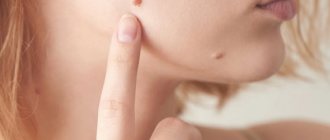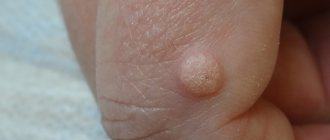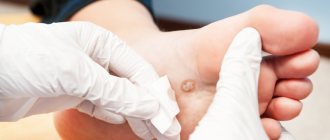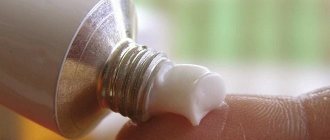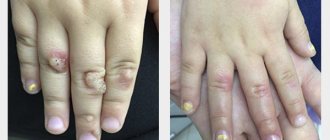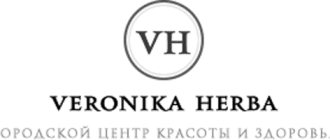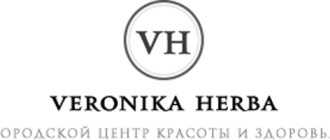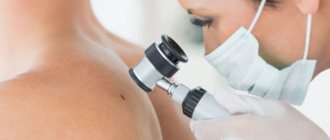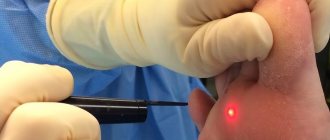Warts on the hands are a benign viral disease in which single or multiple rounded protruding papules of various sizes appear on the skin - from 1 mm to 1.5 cm (sometimes more), gray or flesh-colored. In addition to the skin of the hands, warts can appear on other parts of the body (face, anogenital area, soles of the feet, etc.), as well as on mucous membranes.
The formations tend to spread, merge into large conglomerates, rapidly grow, bleed when injured, and relapse. Self-treatment using questionable methods leads to the appearance of scars, and malignant degeneration is possible on the mucous membranes. Therefore, the problem cannot be ignored.
Sometimes warts can disappear without treatment within 2 years. However, you should not rely on this, since the pathogen still remains in the body and, against the background of a weakened immune system, the formations will make themselves felt again. And over time, they may become less sensitive to therapeutic effects. Therefore, it is important to remove them and, in some cases, undergo antiviral therapy and immunocorrection.
Characteristics of chicken wart
The content of the article
The neoplasm, popularly called a chicken wart, is also called a spine. When such a wart appears, it is smooth, but as it grows it becomes rough. In the center of the neoplasm there is a small papilla, from which a vertical stalk grows.
Most often, several of these legs grow, which is why, upon careful examination, the chicken wart looks like a cauliflower. The color of such warts is usually gray-yellow.
Chicken warts are most often localized on the feet, fingers, palms, and sometimes on the eyelids. Warts located on the feet are often confused with calluses due to the strong keratinization that is characteristic of chicken warts in this area of the body.
When you steam your feet and clean the top layer of the wart, you can see many small dark dots on the surface. This is what clogged capillaries look like.
Traditional methods
How to remove chicken wart on the leg using folk remedies? Choose your favorite recipe. But doctors advise carefully getting rid of papillomas so that the removed growth does not provoke the development of the disease. Therefore, they are categorically against such “treatment”, when the stem of the wart is cut off or it is torn off mechanically.
You will remove the growth, but with such actions you will provoke the growth of a new one. There may be more of them. Or you will get an infection that will cause an inflammatory process.
Therefore, treat yourself correctly, even with folk remedies. How to remove a chicken wart from a leg? Let's look at the most popular means. Before using them, steam your feet and carefully remove the top layer of the wart with a pumice stone or nail file.
A green apple will remove a wart from a child’s delicate skin
Plant based
- Celandine. This plant helps remove all growths. Its fresh juice is used. Lubricate the growth with it. The method is good, but it is used only in the summer. If you want to use it at other times of the year, make an ointment with celandine. But be careful, because the plant is poisonous. Collect celandine after rain. Squeeze the juice from the stem of the plant. Leave it for 2 days. Dilute 1 part juice in 0.5 parts vodka. Dilute the resulting celandine extract with petroleum jelly or glycerin. The ointment is ready.
- Garlic. Prepare a paste of garlic and apply it to the callus every day. Attach gauze folded in several layers to the top. To prevent the compress from falling off, wrap your foot with a bandage. It is better to carry out these procedures in the evening. In the morning, remove the bandage and wash off the garlic. Sometimes there are unpleasant sensations. Or use a different recipe. Lubricate garlic juice with ground lard in a 1:1 ratio. Apply the resulting ointment to the wart on your leg several times a day.
- Raw potatoes. The method we wrote about above helps. But garlic has an unpleasant smell. If you don't like it, replace the garlic with raw potatoes. Otherwise, the treatment is the same: potato pulp is applied to the growth, fixed, and left overnight.
- Green apple. If you had to remove a growth on a child’s leg, where the skin is tender and soft, use products that will not cause discomfort. Lubricate the growth with green apple juice 2 - 3 times a day. The method works if the wart has not yet grown. Within a week you will notice improvements.
- Onion. This is a simple and effective method. Take 2 onion halves and leave in table vinegar for several hours. In the evening, stick half of the onion to the growth and wrap it with a bandage so that it does not fall. Do not remove the compress for 2 - 3 hours, or better leave it overnight. Then replace this onion with the other half. Repeat these steps until the wart falls off. Or prepare onion ointment and lubricate the growth with it. You will need 1 tbsp. onion juice and 0.5 tbsp. honey Mix them and apply to the growth.
- Green onions. In summer, treatment is carried out with green onions. Select the thickest feathers of green onions and soak them in vinegar for several hours. A piece is torn off from an onion feather, the same size as the wart. It is glued to the growth, and an adhesive plaster is applied on top. From time to time, replace the old piece of onion with a new one. Treatment ends when the growth disappears.
- Fir branches. Go to the forest and cut spruce branches 15 cm long. At home, fill them with water and boil for 5 minutes. Wait until the broth cools down. Take foot baths with this decoction every other day. After this treatment, the wart will darken and begin to dry out. Within a week you will notice results.
- Dandelion. Collect dandelion and apply its juice to the wart 4 to 5 times a day.
- Kalanchoe. Collect Kalanchoe leaves and prepare a paste from them. Place it on the growth and bandage it. Change the bandage every day.
Garlic is applied to the wart overnight
Vinegar based
How to get rid of chicken wart on the foot? You will need vinegar. This is a simple way, but it works. Prepare your foot, steam it, and then carefully, using a pipette or syringe, drop 2 to 3 drops of vinegar (9%) onto the wart. It will hurt a little.
It is better to be treated in the evening, before bedtime. Or buy apple cider vinegar. Soak a piece of cotton wool in it, apply it to the growth, and bandage it.
Do not remove the compress for 1 hour. Then remove it and immerse your foot in hot water. Add a decoction of chamomile flowers to it. Keep your foot in hot water for up to 20 minutes or a little less, then carefully remove the stratum corneum with a pumice stone. You will have to repeat the procedure every day for 2 - 3 weeks.
Chicken wart is contagious
The cause of any warts is infection with the human papillomavirus. Penetration of this virus into the body can occur due to many reasons:
- Transmission from person to person by tactile contact;
- When using common items (towels, shoes, personal hygiene items, cosmetics);
- Insufficient compliance with personal hygiene rules;
- Increased sweating;
- Insufficient foot hygiene;
- Wearing uncomfortable shoes, foot deformation, flat feet, leading to skin injury;
- Open wounds on the skin of the feet or hands through which the virus can enter the body;
- Diabetes mellitus, atherosclerosis, varicose veins in the fourth stage, reducing immunity and damaging blood vessels.
If a person has a strong enough immune system, it is more difficult for the virus to enter the body. But even if this does happen and a wart forms, the immune system itself copes with the virus and the tumor quickly disappears.
However, if local and general immunity is weakened, the virus actively multiplies and rapid growth of warts occurs, which can only be gotten rid of with medical help.
Symptoms
Signs of papilloma infection include:
- the appearance of growths and roughness of different sizes with black spots inside, dividing them into mother (large) and daughter (small);
- pain when walking;
- gradual increase in wart size;
- itching and redness of the pathological area.
Early detection of the initial stage of the disease will help prevent its further development and relieve the onset of possible complications.
If the sore is injured, the infection can spread throughout the body.
Diagnosis and treatment
If a chicken wart occurs, you must consult a dermatologist for diagnosis and determine the method of treatment. During the examination, the doctor assesses the condition of the tumor and refers the patient to the necessary laboratory tests. This is necessary to exclude an oncological process and contraindications for removal.
The doctor then offers options for removing the wart. Currently, several methods of wart removal are widely used:
- Laser removal is the safest and most effective method, allowing you to quickly remove a wart without pain and without leaving scars;
- Electrocoagulation - the use of high-frequency current to get rid of warts;
- Cryodestruction - removal of tumors with liquid nitrogen;
- Radio wave removal is the latest method for safely removing warts using a radio knife without scarring;
- Surgical removal - used to remove large warts.
The dermatologist decides which removal method is appropriate. The doctor takes into account the size and location of the warts. The doctor also calculates the risks of complications - bleeding, long healing, the possibility of an unsightly scar, etc.
In most cases, preference is given to a laser or radio knife, as they reduce the risks of health problems and cosmetic defects to zero.
Review of wart removal products: composition
I will not write the trade names of the drugs, I will simply list the active ingredients often found in their compositions and their properties.
1. Phenol, also known as carbolic acid
Here and further I will provide screenshots describing the properties of substances from Wikipedia.
Can phenol be used to remove warts?
Sign up for the webinar “Carcinogens in cosmetics: truth, lies and... marketing”
Please don’t think that I’m trying to shock you with words about toxicity, not at all. Of course, “the dose makes the poison.” However, I would like to note that there are no “natural/folk/gentle/soft” substances in the composition of the products. This substance simply burns the formation on the skin, i.e. causes a chemical burn.
2. Alkalis: sodium hydroxide (NaOH), also known as caustic soda, also known as sodium hydroxide; potassium hydroxide (KOH), potassium hydroxide
Can alkalis be used to remove warts?
3. Lapis, lapis pencil, also known as silver nitrate (AgNO3)
Can a lapis pencil (lapis) be used to remove warts?
4. Acetic acid
Can vinegar be used to remove warts?
5. Nitric acid (HNO3)
Can nitric acid be used to remove warts?
6. Any herbal ingredients
As much as we might like it, plants like jarutka, aspen, ivy, sundew, and celandine have NOT been proven effective in treating warts. I urge you not to trust stories like: “My grandmother’s aunt applied celandine to a wart, and everything went away.”
Are products with herbal ingredients effective in treating warts?
7. Salicylic acid (proven to be effective)
Perhaps the most harmless substance among these. The instructions for use note that it “suppresses the secretion of the sebaceous and sweat glands. In low concentrations it has a keratoplastic effect, and in high concentrations it has a keratolytic effect.” There are studies that confirm the effectiveness of this substance specifically in the treatment of warts [1], [2].
Please wait, run to the pharmacy for salicylic acid to finally get rid of “these terrible warts” - first read the article.
8. A mixture of propane and dimethyl ether (proven effectiveness)
The names of drugs usually include the prefix cryo.
A few studies of this method [3] have shown that its effectiveness in treating warts is comparable to liquid nitrogen. These substances cool the skin wart to a temperature that causes necrosis of the neoplasm.
9. Ointment with imiquimod (effectiveness proven)
In a literature review, which you can view here [4], the authors claim that imiquimod is effectively used in the treatment of simple and recurrent warts. At the same time, larger studies are needed to clarify how to use it most effectively.
Prevention
A wart is infectious in nature and is spread by contact with an infected person or his personal items. To avoid infection, you should:
- wash your hands more often (after visiting the street, public places, traveling in transport, meeting strangers), constantly maintain hygiene of the whole body;
- prevent vitamin deficiencies, strengthen the immune system (walk in the fresh air, eat fresh vegetables and fruits, take vitamin complexes);
- wear rubber slippers in baths, saunas and swimming pools;
- wear exclusively your own clothes and shoes;
- avoid damage to the skin, treat it with an antiseptic solution and heal it;
- promptly identify and treat infectious diseases;
- lead a healthy lifestyle, play sports, do gymnastic exercises.
A callus that appears on the leg causes its owner significant physical and psychological discomfort: a person feels pain when walking, and the appearance of the limb deteriorates. There is also a high risk of injury to the formation and spread of infection through the bloodstream to other parts of the body; transformation of the wart into an oncological malignant tumor may occur.
To avoid the development of complications and maintain your health, you should get rid of the pathology immediately, when its very first signs appear.
